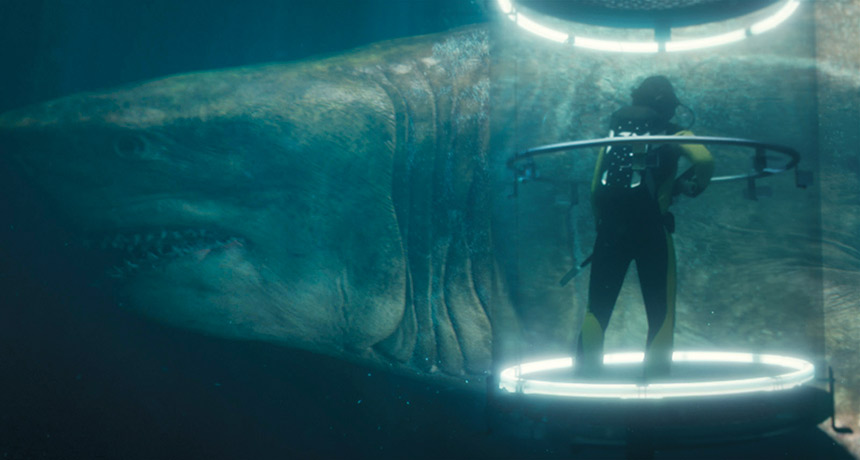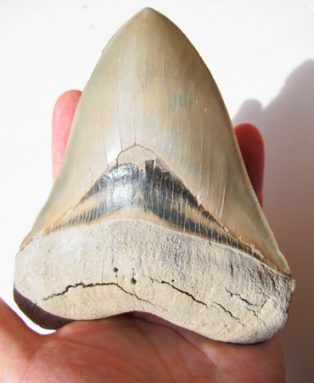What ‘The Meg’ doesn’t quite get right about megalodon sharks
A paleobiologist helps separate fact from fiction in the film

Courtesy of Warner Bros. Pictures
What if a gigantic prehistoric shark — one thought to be extinct for some 2.5 million years — still lurks in the ocean’s depths? That’s the premise of The Meg, a flick which opened August 10. This movie pits massive Carcharocles megalodon against a a handful of resourceful scientists. There’s also a grizzled and fearless deep-sea rescue diver, played by Jason Statham.
The main characters discover the sharks in a deep oceanic trench about 300 kilometers (190 miles) off the coast of China. The film suggests this trench extends more than 11,000 meters (6.8 miles) below the sea surface. That would make it deeper than the Mariana Trench’s Challenger Deep (which is the actual deepest known point in the ocean).
Hydrothermal vents down in the movie’s trench supposedly keep its dark waters warm enough to support an ecosystem teeming with life. And — spoiler alert! — of course, the scientists inadvertently help the giant living fossils escape and head to the surface. There, the megalodons terrorize shark fishermen and beachgoers a la Jaws.
But could a population of these mega-sharks actually have survived down in those mega-depths? Meghan Balk is a paleobiologist who studies the ancient predators. She works at Smithsonian’s National Museum of Natural History in Washington, D.C. And she weighed in for us on what is and is not possible — and what we still don’t know about sharks.
Q: Did megalodons ever actually get as big as they are in the movie? A: Extremely unlikely
Monster-size sharks in The Meg reach lengths of 20 to 25 meters (66 to 82 feet). That’s massive, although a tad smaller than the longest known blue whales. Scientists have made estimates of how big C. megalodon got, based on the size of their fossil teeth. Even the largest reached only 18 meters (about 60 feet). “And that was the absolute largest,” Balk says. On average, C. megalodon tended to be around 10 meters (33 feet) long, she says. That still made them much longer than the length of the average great white shark, which tops out at around 5 to 6 meters (16 to 20 feet). So real megalodons were far smaller than the movie’s versions.
Q: Would a megalodon otherwise look like the film version? A: Yes and no

The movie’s sharks aren’t entirely inaccurate representations, Balk says. Sharks in general have between five and seven gills. The movie’s megalodons correctly have six gills, she notes. And the shape of their dorsal fin is, appropriately, modeled after the great white shark’s. The great white is the closest modern relative to the ancient megalodons. Also, a male meg in the film even has “claspers.” These are appendages under the abdomen used to hold a female during mating. “When I looked at it, I was like: ‘Oh, they did a pretty good job,’” Balk says. “They didn’t just create a random shark.”
On the other hand, it’s actually a bit odd that the movie’s megalodons wouldn’t have evolved some significant differences from their prehistoric ancestors, Balk says. “Like the eye getting bigger” to see better, she says. Or maybe they would have become blind after a few million years living in the darkness of the deep sea. You might even expect dwarfism. Populations can shrink in size when they are restricted by geographic isolation — such as potentially being stuck within a trench.
Q: Would such huge sharks have had enough to eat down there? A: Extremely unlikely
In general, Balk notes, “there’s just not enough energy in the deep sea” to sustain giant sharks. Life does bloom at hydrothermal vents. But the deepest known hydrothermal vents are only about 5,000 meters (3.1 miles) deep. And even if there were vents in the deepest trenches, it’s not clear there would be enough big species milling around down there to feed not just one massive shark, but a whole population of them. In the film, the vent field is populated with many smaller species known to cluster around hydrothermal vents. These include shrimps, snails and tube worms. Viewers also see one giant squid. However, there would have had to be a whole lot more food of that size. C. megalodon — like modern great whites — ate many different things, from orcas to squid. And the humongous megalodons in the movie would have needed to eat “a lot of squid,” Balk says, laughing.
Q: Could sharks live at such depths? A: Unlikely
How deep within the ocean sharks can live remains a big unknown. “Quantifying the depth that sharks go to is a big endeavor right now,” Balk says. Few sharks are known to inhabit the abyssal regions — such as sites down to 4,000 meters (2.5 miles) or more. What moves within oceanic trenches more than 6,000 meters (3.7 miles) down is a true mystery. Aside from the scarcity of food, temperatures there could be another limitation to deep-sea living.
There are sharks that inhabit deep parts of the ocean. Among them are goblin sharks and Greenland sharks, which tend to have low metabolic rates. That means they move slowly, Balk says — much more slowly than the energetic predators of the movie. Although C. megalodon cruised seas across the globe, it tended to prefer warm, shallower waters. It even used coastal regions for nursing grounds.
Q: So, could megalodons have survived to modern times without humans knowing about it? A: Extremely unlikely
Sharks shed a lot of teeth throughout their lives. Those teeth are the main fossil evidence of the life and times of prehistoric sharks. Fossilized C. megalodon teeth found in sediments around the world suggest that the creatures lived between about 14 million and 2.6 million years ago. They might not have gone extinct, at the latest, until 1.5 million years ago, Balk says. In fact, it’s not clear why they went extinct. There are, however, a few hypotheses. Perhaps they had to compete for food with too many other creatures, such as orcas. Or they might have been affected by changes in ocean circulation some 3 million years ago, back when the Isthmus of Panama formed. Maybe nearshore nursery sites vanished. Or their prime prey might have disappeared when some marine mammals went extinct about 2.6 million years ago.
Bottom line: The sheer abundance of shed teeth — as many as 20,000 per shark throughout its lifetime — is one of the strongest arguments against megalodon surviving into modern times, Balk says. “That’s one of the reasons why we know megalodon’s definitely extinct. We would have found a tooth.”







